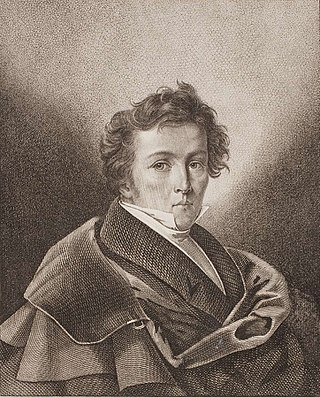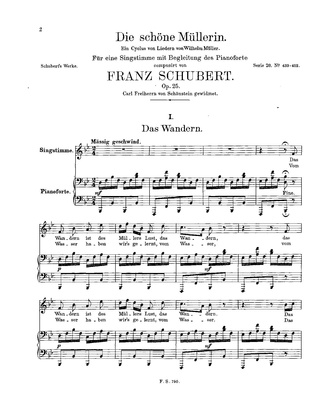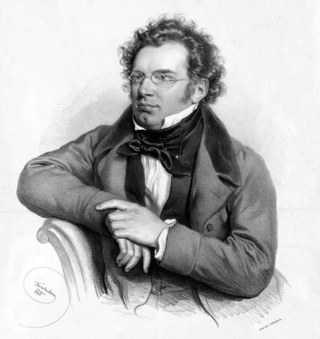
Franz Peter Schubert was an Austrian composer of the late Classical and early Romantic eras. Despite his short life, Schubert left behind a vast oeuvre, including more than 600 secular vocal works, seven complete symphonies, sacred music, operas, incidental music, and a large body of piano and chamber music. His major works include the art songs Erlkönig, Gretchen am Spinnrade, Ave Maria; the Trout Quintet, the unfinished Symphony No. 8 in B minor, the "Great" Symphony No. 9 in C major, the String Quartet No. 14 "Death and the Maiden", a String Quintet, the two sets of Impromptus for solo piano, the three last piano sonatas, the Fantasia in F minor for piano four hands, the opera Fierrabras, the incidental music to the play Rosamunde, and the song cycles Die schöne Müllerin, Winterreise and Schwanengesang. Born in the Himmelpfortgrund suburb of Vienna, Schubert showed uncommon gifts for music from an early age. His father gave him his first violin lessons and his elder brother gave him piano lessons, but Schubert soon exceeded their abilities. In 1808, at the age of eleven, he became a pupil at the Stadtkonvikt school, where he became acquainted with the orchestral music of Joseph Haydn, Wolfgang Amadeus Mozart, and Ludwig van Beethoven. He left the Stadtkonvikt at the end of 1813 and returned home to live with his father, where he began studying to become a schoolteacher. Despite this, he continued his studies in composition with Antonio Salieri and still composed prolifically. In 1821, Schubert was admitted to the Gesellschaft der Musikfreunde as a performing member, which helped establish his name among the Viennese citizenry. He gave a concert of his works to critical acclaim in March 1828, the only time he did so in his career. He died eight months later at the age of 31, the cause officially attributed to typhoid fever, but believed by some historians to be syphilis.
A song cycle is a group, or cycle, of individually complete songs designed to be performed in sequence, as a unit.

Johann Ludwig Wilhelm Müller was a German lyric poet, best known as the author of Die schöne Müllerin (1823) and Winterreise (1828). These would later be the source of inspiration for two song cycles composed by Franz Schubert.

Dietrich Fischer-Dieskau was a German lyric baritone and conductor of classical music. One of the most famous Lieder performers of the post-war period, he is best known as a singer of Franz Schubert's Lieder, particularly "Winterreise" of which his recordings with accompanists Gerald Moore and Jörg Demus are still critically acclaimed half a century after their release.

Die schöne Müllerin, is a song cycle by Franz Schubert from 1823 based on 20 poems by Wilhelm Müller. It is the first of Schubert's two seminal cycles , and a pinnacle of Lied repertoire.

Winterreise is a song cycle for voice and piano by Franz Schubert, a setting of 24 poems by German poet Wilhelm Müller. It is the second of Schubert's two song cycles on Müller's poems, the earlier being Die schöne Müllerin.

Heinrich Friedrich Ludwig Rellstab was a German poet and music critic. He was born and died in Berlin. He was the son of the music publisher and composer Johann Carl Friedrich Rellstab. An able pianist, he published articles in various periodicals, including the influential liberal Vossische Zeitung, and launched the music journal Iris im Gebiete der Tonkunst, which was published in Berlin from 1830 to 1841. His outspoken criticism of the influence in Berlin of Gaspare Spontini landed him in jail in 1837.
"Der Doppelgänger" is one of the six songs from Franz Schubert's Schwanengesang that sets words by Heinrich Heine for piano and tenor voice. It was written in 1828, the year of Schubert's death.

Dichterliebe, "A Poet's Love", is the best-known song cycle by Robert Schumann. The texts for the 16 songs come from the Lyrisches Intermezzo by Heinrich Heine, written in 1822–23 and published as part of Heine's Das Buch der Lieder. Along with the song cycles of Franz Schubert, Schumann's form the core of the genre in musical literature.
Susan Youens is the author of many books on German lieder. A musicologist, her work on Franz Schubert and Hugo Wolf is considered some of the most scholarly and useful material on these composers. Both musicologists and performers have often cited her work.

Johann Vesque von Püttlingen, born J. Vesque de Puttelange, was an Austrian lawyer, diplomat, author, composer and singer. His full name and title in German was Johann Vesque, Freiherr von Püttlingen.

Ingeborg Bronsart von Schellendorf was a Finnish-German composer.
David Willison is an English pianist. Between 1961 and 1999 he was the regular accompanist of the baritone Benjamin Luxon in recitals and recordings.
Gerold Huber is a German classical pianist, best known as the regular duo partner of baritone Christian Gerhaher and accompanist of other singers.

Franz Schubert's best known song cycles, like Die schöne Müllerin and Winterreise are based on separate poems with a common theme and narrative. Other song cycles are based on consecutive excerpts of the same literary work: Schubert's "Ave Maria" is part of such a song cycle based on excerpts of the same poem, in this case by Walter Scott.

"Ständchen", D 889, is a lied for solo voice and piano by Franz Schubert, composed in July 1826 in the then village of Währing. It is a setting of the "Song" in act 2, scene 3 of Shakespeare's Cymbeline. The song was first published by Anton Diabelli in 1830, two years after the composer's death. The song in its original form is relatively short, and two further verses by Friedrich Reil were added to Diabelli's second edition of 1832.
Franz Schubert composed a number of works known as Ständchen, meaning serenade.
Florian Prey is a German opera singer. He is the son of German baritone Hermann Prey.

Wolfgang Leibnitz is a German classical pianist.

"Das Wandern ist des Müllers Lust" is the first line of a poem by Wilhelm Müller, written in 1821 with the title "Wanderschaft" as part of a collection, Die schöne Müllerin. While wandern is defined as "hiking" today, it referred to the required journeyman years of craftsmen when written, in this case of a miller.















